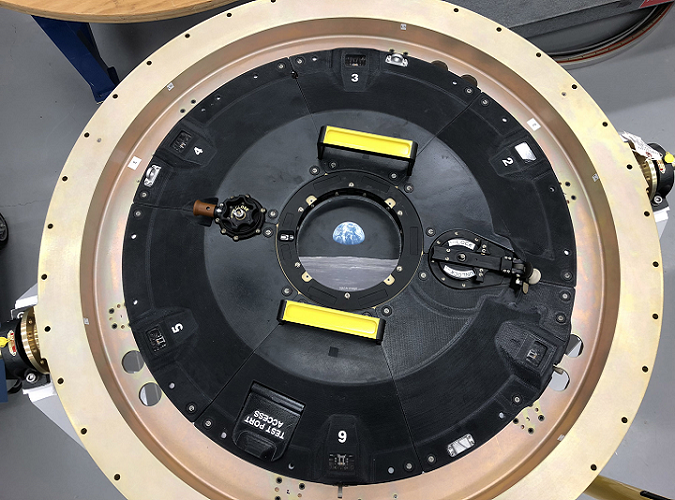Stratasys (NASDAQ: SSYS) is already in the business of supplying the largest number of 3D printed polymer aerospace parts. Now, the company has qualified yet another polymer for 3D printing for aerospace applications. In conjunction with Lockheed Martin (NYSE: LMT) and Metropolitan State University of Denver, the company has released the baseline material qualification data for its Antero 840CN03 filament, used to 3D print parts for the Orion spacecraft.
“We want to demonstrate a new model for how industry, manufacturers and academia can collaborate to gather and release material qualification data that helps accelerate the adoption of additive manufacturing across the aerospace industry,” said Foster Ferguson, Director of Aerospace for Stratasys.
Antero 840CN03 is a PEKK-derived composite thermoplastic with electrostatic discharge (ESD) qualities necessary for use in space applications. The material meets ESD and NASA outgassing requirements and exceeds flame, smoke, and toxicity (FST) characteristics required for aviation. Baseline data was collected by 3D printing over 280 test coupons made from Antero 850CN03 on Stratasys Fortus F900 3D printers at Lockheed Martin facilities in Littleton, Colo., and Stratasys Direct Manufacturing in Belton, Texas. These tests demonstrated tensile strength properties and confirmed the performance of the polymer shown in academic studies. Additional testing will examine other properties to further inform the work of design engineers for other uses.
“We are continually looking for ways to drive innovation for flight-qualified materials and additive manufacturing is key to that endeavor,” said Cris Robertson, Associate Manager of Advanced Manufacturing at Lockheed Martin Space. “Through our collaboration with Stratasys and MSU Denver, we have collected the data necessary to qualify Antero 840CN03 for flight parts and we are now able to expand our use of the material beyond our initial applications on the Orion vehicle.”
“These types of research and development collaborations with leading companies like Stratasys and Lockheed Martin enable our students to be well prepared to help their future aerospace employers with adopting the latest technology in the industry,” said Mark Yoss, Director of the Advanced Manufacturing Sciences Institute at MSU Denver. “By publishing this material qualification data, we can help move the aerospace industry forward by establishing more standards in additive manufacturing.”
In 2018, Stratasys and Lockheed Martin published allowable data for SABIC ULTEM 9085 resin 3D printed using a Fortus 900mc 3D printer. This was only one development in the companies’ partnership, which also included 3D printing over 200 parts for the Orion spacecraft. Stratasys has also qualified another PEKK material, Antero 800NA, for use by Boeing. The public release of the material qualification data is meant to expand the adoption of the material in aerospace applications.

The Orion spacecraft leverages a variant of new Stratasys Antero 800NA to build an intricately-connected 3D printed docking hatch door.
By qualifying a growing range of materials for such high-performance use-cases, Stratasys can also attempt to maintain an edge over the new generation printer manufacturers looking to compete with their own industrial extrusion 3D printers. This includes firms like Roboze and 3DGence, who have developed cost-competitive thermoplastic deposition machines with the ability to 3D print high-temperature materials, including PEKK. As it stands, Stratasys is still much larger with more resources, perhaps allowing it to qualify these polymers at a faster rate than newcomers may be able to.
The full data report is now available to the public online, with more characterization to take place with future testing. Stratasys and Lockheed Martin will also showcase the material at this year’s Space Symposium in Colorado Springs, Colo.
Subscribe to Our Email Newsletter
Stay up-to-date on all the latest news from the 3D printing industry and receive information and offers from third party vendors.
You May Also Like
Precision at the Microscale: UK Researchers Advance Medical Devices with BMF’s 3D Printing Tech
University of Nottingham researchers are using Boston Micro Fabrication‘s (BMF) 3D printing technology to develop medical devices that improve compatibility with human tissue. Funded by a UK grant, this project...
3D Printing Webinar and Event Roundup: April 21, 2024
It’s another busy week of webinars and events, starting with Hannover Messe in Germany and continuing with Metalcasting Congress, Chinaplas, TechBlick’s Innovation Festival, and more. Stratasys continues its advanced training...
3D Printing Webinar and Event Roundup: March 17, 2024
It’s another busy week of webinars and events, including SALMED 2024 and AM Forum in Berlin. Stratasys continues its in-person training and is offering two webinars, ASTM is holding a...
3D Printed Micro Antenna is 15% Smaller and 6X Lighter
Horizon Microtechnologies has achieved success in creating a high-frequency D-Band horn antenna through micro 3D printing. However, this achievement did not rely solely on 3D printing; it involved a combination...






























